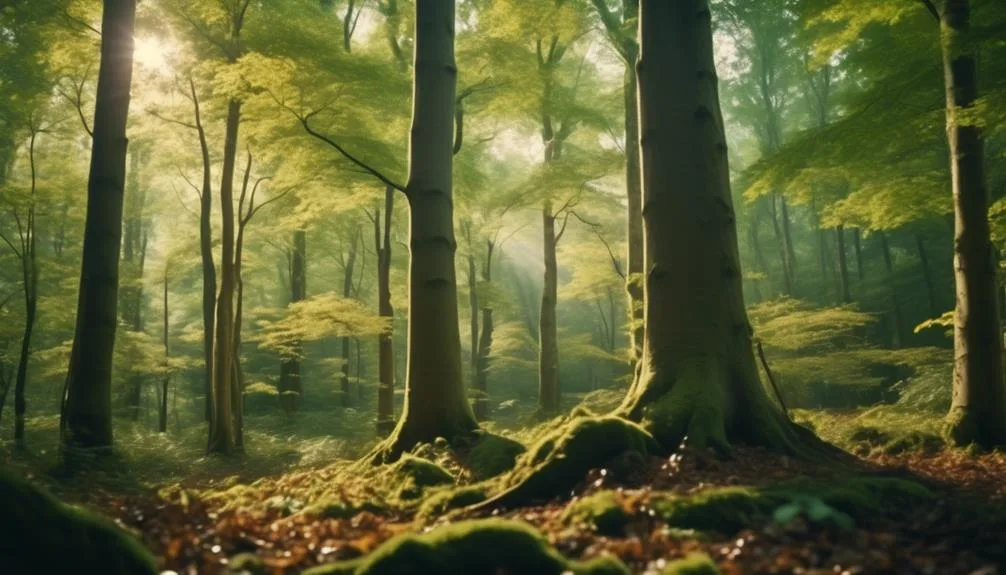Beech trees can live for over 300 years and are vital for supporting wildlife.
You can create a natural haven in your backyard by planting beech trees, which attract diverse birds, insects, and mammals.
These trees not only enhance your landscape but also provide a crucial habitat for wildlife.
Let's discover how beech trees contribute to a thriving ecosystem and transform your surroundings into a flourishing habitat for various species.
Beech Trees: An Ideal Wildlife Habitat
Beech trees provide an ideal habitat for wildlife, offering shelter, food, and a complex ecosystem that supports a diverse range of species. Their dense canopies and sturdy trunks provide shelter for birds, small mammals, and insects. Beech nuts are a crucial food source for various wildlife, including deer, squirrels, and birds.
The fallen leaves and branches create a rich, organic layer on the forest floor, enriching the soil and supporting a myriad of decomposers and fungi. The ecological importance of beech trees can't be overstated. Their presence contributes to the overall health and diversity of forest ecosystems, playing a vital role in maintaining the balance of nature.
Beech Tree Planting and Maintenance
When establishing a beech tree habitat, it's crucial to carefully select the planting site and implement proper maintenance practices to ensure the trees' healthy growth and longevity. Here are some essential tree care and landscaping benefits to consider:
- Soil Requirements: Beech trees thrive in well-drained soil with a slightly acidic to neutral pH level.
- Watering: Provide adequate water, especially during the tree's first few years, to establish a strong root system.
- Pruning: Regularly inspect and prune the trees to remove dead or damaged branches and maintain their overall shape.
- Mulching: Apply a 2-4 inch layer of organic mulch around the base of the tree to retain moisture and suppress weed growth.
- Protection: Utilize tree guards or fencing to protect young beech trees from wildlife and mechanical damage.
Proper tree care and maintenance won't only ensure the health and beauty of your beech trees but also enhance the overall landscaping of your habitat.
Attracting Wildlife With Beech Trees
Attract a diverse array of wildlife to your habitat by strategically incorporating beech trees into your landscaping. Beech trees offer numerous benefits to wildlife and are essential for wildlife conservation efforts.
These majestic trees provide abundant nuts, which are a valuable food source for various animals, including deer, squirrels, and birds. Their dense foliage and sturdy branches offer shelter and nesting sites for numerous bird species. Additionally, the year-round canopy of beech trees provides cover for small mammals and insects.
Beech Trees and Biodiversity
Enhancing your wildlife habitat with beech trees not only attracts a diverse array of wildlife but also significantly contributes to the biodiversity of the ecosystem. Beech trees play a crucial role in supporting biodiversity through various means:
- Nutrient Cycling: Beech trees contribute to the recycling of essential nutrients in the ecosystem, promoting the growth of diverse plant species.
- Wildlife Shelter: The dense canopy and large size of beech trees provide shelter for a wide range of wildlife, from birds and mammals to insects and fungi.
- Food Source: Beech trees produce beechnuts, which are an important food source for many species, including deer, squirrels, and birds.
- Soil Stability: Their extensive root systems help prevent soil erosion, maintaining the stability of the ecosystem.
- Microhabitat Creation: Beech trees create unique microhabitats within the forest, supporting a variety of specialized plant and animal species.
Sustainable Wildlife Habitat Management
To ensure the long-term health and diversity of your wildlife habitat, it's essential to implement sustainable management practices that support the needs of various species. This involves pollinator conservation, habitat restoration, and maintaining ecosystem balance for wildlife preservation. One way to achieve this is by incorporating diverse plant species that offer food and shelter for a wide range of wildlife. Additionally, controlling invasive species and minimizing chemical pesticide use can help maintain a healthy habitat. Regular monitoring of the habitat's condition and biodiversity is crucial for making informed management decisions. By promoting a balanced and thriving ecosystem, you contribute to the overall well-being of the wildlife in your habitat.
| Sustainable Management Practices | ||
|---|---|---|
| Pollinator Conservation | Habitat Restoration | Ecosystem Balance |
| Provide native flowering plants | Reestablish native | Control invasive species |
| Create nesting sites | vegetation | Minimize pesticide use |
| Support diverse pollinator | Repair degraded areas | Monitor habitat biodiversity |
Conclusion
In nurturing your beech tree habitat, you're fostering a thriving ecosystem that supports diverse wildlife. By practicing sustainable management, you play a vital role in preserving biodiversity.
Witness the beauty of nature as your beech trees become a sanctuary for a variety of life. How will your habitat impact the natural world around you?

My interest in trees started when I first saw the giant sequoias in Yosemite.
I was a teenager then, and I remember thinking, “I need to learn more about this.”
That moment stuck with me.
A few years later, I went on to study forestry at Michigan Tech.
Since graduating, I’ve worked in a mix of hands-on tree care and community education.
I’ve spent over ten years helping people understand how to plant, maintain, and protect the trees in their neighborhoods.
I don’t see trees as just part of the landscape.
They are living things that make a real difference in our daily lives.
